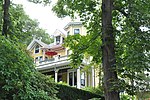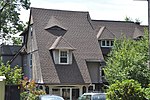Lynch-O'Gorman House
Houses completed in 1889Houses in Brookline, MassachusettsHouses on the National Register of Historic Places in Norfolk County, MassachusettsNational Register of Historic Places in Brookline, MassachusettsNorfolk County, Massachusetts Registered Historic Place stubs ... and 1 more
Queen Anne architecture in Massachusetts

The Lynch-O'Gorman House is a historic house at 41 Mason Terrace in Brookline, Massachusetts. Design of this house has been attributed to Arthur Vinal, a prominent area architect; it is an elaborately-decorated Queen Anne Victorian that was built in 1889 by Charles Sias on Beacon Street. It was moved to its present location on Mason Terrace in 1903. The house features the typical high-style Queen Anne profusion of shapes and texture.The house was listed on the National Register of Historic Places in 1985.
Excerpt from the Wikipedia article Lynch-O'Gorman House (License: CC BY-SA 3.0, Authors, Images).Lynch-O'Gorman House
Lancaster Terrace,
Geographical coordinates (GPS) Address Nearby Places Show on map
Geographical coordinates (GPS)
| Latitude | Longitude |
|---|---|
| N 42.340555555556 ° | E -71.132222222222 ° |
Address
Lancaster Terrace 33;39;41
02446
Massachusetts, United States
Open on Google Maps







